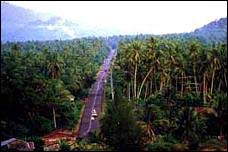|
Culture
Malaysia
is a multicultural society, with Malays, Chinese and Indians living
side by side. The Malays are the largest community. They are
Muslims, speak Bahasa and are largely responsible for the political
fortunes of the country. The Chinese comprise about a third of the
population. They are Buddhists and Taoists, speak Hokkein, Hakka and
Cantonese, and are dominant in the business community. The Indians
account for about 10% of the population. They are mainly Hindu
Tamils from southern India, they speak Tamil, Malayalam, and some
Hindi, and live mainly in the larger towns on the west coast of the
peninsula. There is also a sizeable Sikh community. Eurasians and
indigenous tribes make up the remaining population. Despite Bahasa
Malaysia being the official language, when members of these
different communities talk to each other, they generally speak
English, which was recently reinstated as the language of
instruction in higher education. |
 |
|
The main
indigenous tribe is the Iban of Sarawak, who number 395,000. They
are largely longhouse dwellers and live along the Rejang and Baram
rivers. The Bidayuh (107,000) are concentrated on
Sarawak's
Skrang
River.
The Orang Asli (80,000) live in small scattered groups in Peninsular
Malaysia. Traditionally nomadic agriculturalists, many have been
absorbed into modern Malaysia.
Malaysian music
is heavily influenced by Chinese and Islamic forms. The music is
based largely around the gendang (drum), but includes percussion
instruments (some made of shells), flutes, trumpets and gongs. The
country has a strong tradition of dance and dance dramas, some of
Thai, Indian and Portuguese origin. Other artistic forms include
wayang kulit (shadow-puppets), silat (a stylised martial art) and
crafts such as batik, weaving and silver and brasswork.
It's not easy
to find authentic Malay food in Malaysian restaurants, though you
can take your pick of Chinese, Nyonya (a local variation on Chinese
and Malay food - Chinese ingredients, local spices), Indian,
Indonesian or (sometimes) Western cuisines. Satays (meat kebabs in
spicy peanut sauce) are a Malaysian creation and they're found
everywhere. Other dishes include fried soybean curd in peanut sauce,
sour tamarind fish curry, fiery curry prawns and spiced curried meat
in coconut marinade. Muslim Indian dishes have developed a
distinctly Malaysian style. The variety of wonderful tropical fruits
and fruit juices available is huge, and strange sweet concoctions
include cendol (sugar syrup, coconut milk and green noodles) and ais
kacang (beans and jellies topped with shaved ice, syrups and
condensed milk). |